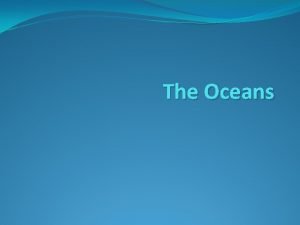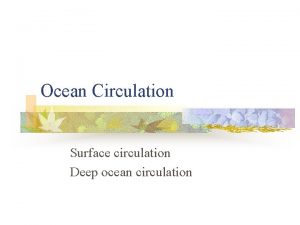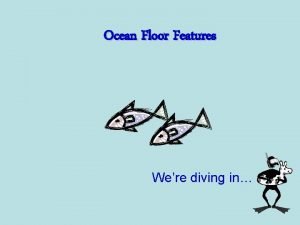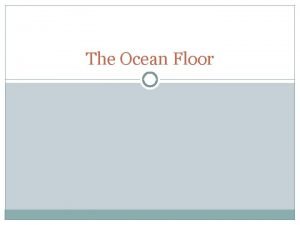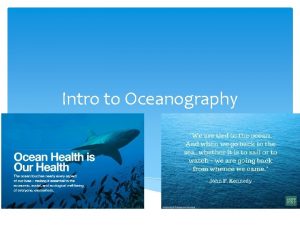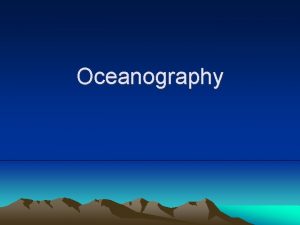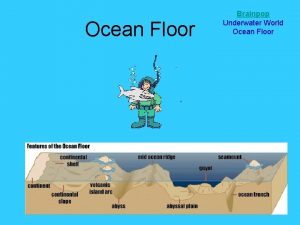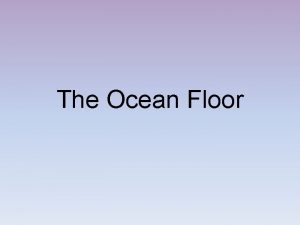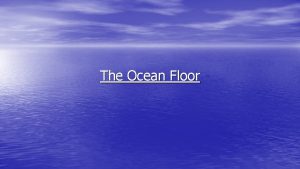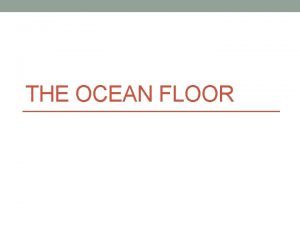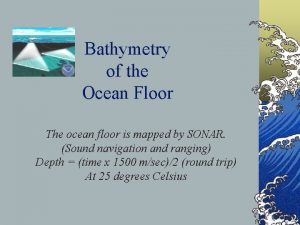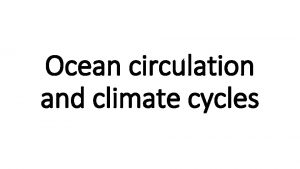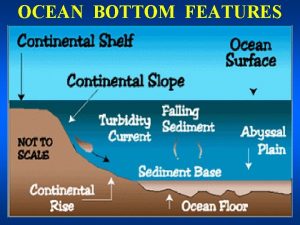Oceanography Ocean Floor Features Ocean Circulation Waves and
















- Slides: 16


Oceanography • Ocean Floor Features • Ocean Circulation • Waves and Tides

Oceans • https: //www. youtube. com/watch? v=3 GRA 7 il. M 708

Ocean Topography

How do we get the information about the ocean floor? • Sonar – Boats using sonar to map the ocean floor as they pass over it. • Boats have to go in set patterns going back and forth just like you would mow a lawn to make sure it covers everything • Slow process • Satellites • Measure the ocean surface height as small as 3 -6 cm • These can be affected by features under the water, help to verify sonar readings • Submersibles • Small underwater craft that can be manned or unmanned. • Give a visual as well as other readings to verify the findings in detail

Sonar • https: //www. youtube. com/watch? v=-f. AAx. EIFe. LU

Starting at the beach • The area where a continental plate meets an oceanic plate is called a Continental Margin. • Most ocean features will be in this range due to plate tectonics

Beach to water • Continental Shelf • Gently sloped underwater surface • Some areas it is very short in width (convergent boundaries) while others can be quite large • Fairly flat, only dropping at about 2 meters per KM (6 feet per mile) • Great source of minerals, oil, natural gas, sand, gravel, and fishing


Continental Slope • The edge of the continental crust where it goes down to the oceanic crust • Much steeper where the water gets deep quickly • Can contain deep cuts called Submarine Canyons that can be ends of ancient rivers • They can also be formed from Turbidity Currents that have a lot of sediment moving at once • Because it is more muddy than normal seawater it is more dense and flows down the side eroding it


Continental Rise • Slope becomes much smaller as the ocean floor starts to flatten • No trenches in this area • Continental Slope leading down can be nearly 20 km wide but the rise can be 100’s of km wide


Ocean Basin Floor • 30% of Earth’s surface is ocean floor • Abyssal Plains • Very deep very flat areas after the continental rise • Probably the flattest places on earth due to lots of sediment settling there at a fairly even rate • Mid-Ocean Ridges • Occur all around the Earth due to seafloor spreading • Divergent oceanic plates allow magma to come up and form ridges and create new ocean floor

Ocean Topography

 Single vs double circulatory system
Single vs double circulatory system Single circulation and double circulation
Single circulation and double circulation Alveolus
Alveolus Earth covered in water
Earth covered in water Compare and contrast p waves and s waves using venn diagram
Compare and contrast p waves and s waves using venn diagram Slowing atlantic ocean circulation
Slowing atlantic ocean circulation Mechanical waves examples
Mechanical waves examples Example mechanical waves
Example mechanical waves How are rainbows made
How are rainbows made Carbon dioxide temperature
Carbon dioxide temperature Difference between matter waves and electromagnetic waves
Difference between matter waves and electromagnetic waves Mechanical and electromagnetic waves similarities
Mechanical and electromagnetic waves similarities Surface waves and body waves
Surface waves and body waves Mechanical waves and electromagnetic waves venn diagram
Mechanical waves and electromagnetic waves venn diagram Constructive
Constructive Citlalli dominguez
Citlalli dominguez Sound waves are transverse waves true or false
Sound waves are transverse waves true or false



